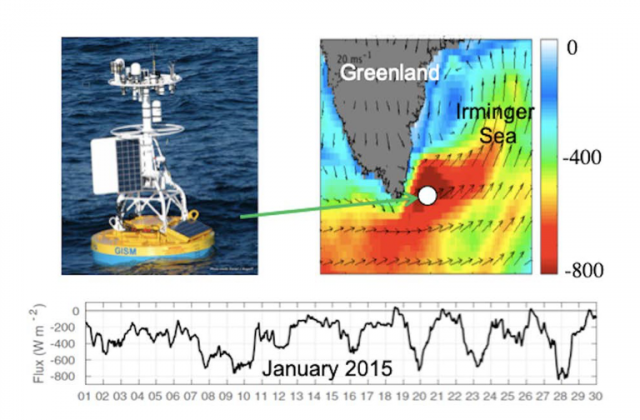Drivers of Ocean Overturning Circulation Revealed
A. Josey, National Oceanography Centre, Southampton, UK, and R. A. Weller, Woods Hole Oceanographic Institution, Woods Hole, MA, USA. Extracted from OOI Science Plan, 2021.
Ocean-atmosphere interaction at mid-high latitudes is of particular importance as it plays a key role in driving variability in ocean properties and in the large-scale thermohaline circulation. In turn, these variations can feedback on the atmosphere modifying the weather and climate of North America and Eurasia.
While the summer season warms the ocean surface, heat and moisture lost to the atmosphere in the winter from the surface of ocean makes surface water more dense. These dense waters sink to great depths in the ocean’s interior, and better understanding of the winter surface fluxes and year to year variability in the overturning is needed. However, obtaining accurate air-sea heat flux measurements under the severe weather conditions experienced at these latitudes is extremely challenging. As a consequence, until the advent of the OOI, there were very few useful high latitude surface flux records in the historical record and none of the multiyear time series needed to develop our understanding of this key component of the climate system.
This situation changed dramatically with the deployment of the Irminger Sea OOI Surface Mooring. This mooring is equipped with the state-of-the-art sensors necessary to accurately characterize the air-sea heat, water and momentum exchanges. It provided the first multi-winter observations from a high northern latitude surface flux buoy and related them to both localized (100-500 km) intense weather conditions and larger scale (~3000 km) modes of atmospheric variability.
The buoy is located in the Irminger Sea between Greenland and Iceland, recently recognized as a key deep ocean convection site (see figure to the right for mooring location). We developed and led a collaboration (US, UK, German, Dutch and Canadian scientists) that carried out a ground-breaking study using the multi-winter observations collected by this OOI mooring (Josey et al., 2019). Previously, model studies and a pilot surface mooring deployment (Vagle et al., 2008) had indicated that Irminger Sea heat loss is strongly influenced by intense atmospheric jets that form at the tip of Greenland. These are caused by the mountainous Greenland terrain which focuses the prevailing westerly wind flow into narrow, very strong jets over the ocean. However, multi-winter observations of the jet impacts on heat loss were lacking.
Our analysis provided the first multi-winter characterization of air-sea exchange in the high latitude North Atlantic from observations. Of great interest was year to year variability in the influence of the Irminger Sea tip jet on winter heat loss. Furthermore, it identified a new mechanism by which the atmosphere controls ocean heat loss leading to dense water formation. The results are particularly important as the connection between air-sea exchanges and the ocean circulation is still poorly understood hindering attempts to understand climate change induced slowdown of the Atlantic circulation and its climate feedbacks.
The analysis revealed not only the jet impacts – extremely strong daily heat loss up to 800 Wm-2 – but also strong variability in their frequency of occurrence. The causes of this variability were a puzzle, which we resolved in terms of a mode of atmospheric variability termed the East Atlantic Pattern (EAP). We analyzed data from the highest resolution weather simulation currently available, in conjunction with the OOI observations, to show that although the EAP center is close to the UK it has a previously unknown far-field influence on atmospheric circulation along the Greenland coast that suppresses jet formation. This research is of wider significance for the global ocean circulation, as the Irminger Sea is one of a few locations in which deep waters of this overturning (conveyor belt-like) circulation form. Better understanding of this formation is needed to determine historical and future ocean circulation variations and our OOI-based study reveals potential impacts via the EAP on the circulation beyond those currently recognized.

